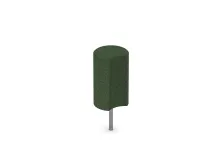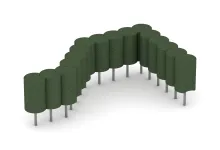Kick protection wall mat – impact protection mat FS "Grass Green"
- /
-
Delivery in approx.
7-14 days - £37.70 / 1 Piece / m²
- (19.50 kg / Piece)
EAN: 4251469307520 | Item no.: 0752
The WARCO kick protection wall mat – impact protection mat is a large-format wall mat for equestrian facilities, sports halls and industrial use. Measuring 100 × 100 cm and available in thicknesses of 3, 4 or 4.5 cm, it provides reliable protection against injuries, damage and noise whenever strong impacts hit walls.
Material and structure
Made of PU-bonded rubber granules, the mat features a heavily profiled back that works as a progressive damping system. On impact, the surface compresses elastically, absorbs the energy, protects joints and immediately returns to its original shape.
Performance and benefits
The mat helps prevent injuries, relieves strain on joints and protects walls and structures from damage such as splintering, dents or chipping. It also effectively reduces noise levels in stables, sports facilities and industrial areas.
Properties and maintenance
The kick protection wall mat – impact protection mat is durable, robust and low-maintenance. It can be easily cleaned with a pressure washer.
Installation
The mats are glued directly to the wall or to a carrier board such as plywood or galvanised steel. The carrier board can be mounted with concealed hooks for easy removal. Direct screwing through the mat is not possible. Connector clips can be used as an installation aid if required.
Cutting
The mats can be cut to size if needed. Straight cuts are made with a circular saw, while a jigsaw can be used for recesses or openings. A blade suitable for rubber, or alternatively for wood, should be used.
Discount
Product Highlights
Characteristics
Product Details – Material and Structure
Comparative values
To calculate how many tiles you need for your project, simply use the online installation planner available in the shop. This free browser-based tool is directly accessible on each product page – just below the price and quantity selection. Click on “Plan installation” to open the tool instantly – no registration or download required.
Enter the dimensions of your area, such as the length and width in metres. The planner will then automatically calculate the total number of tiles required, including a realistic allowance for offcuts. You’ll also be shown a suitable layout pattern for the selected product. The tool is user-friendly, accurate and ideal for planning your material requirements with confidence.
Yes, that is the standard approach. The vast majority of our customers – whether private, municipal, or commercial – install the delivered WARCO tiles themselves or with their own staff. The installation is simple and requires no special skills. Only fitting the curb into a concrete foundation with back support demands a little extra craftsmanship. Cutting the elements to size and laying them on a suitable substrate is not challenging. You can find all essential installation information in our Expert Advice – FAQ section on our website.
WARCO offers several connection systems for floor tiles, each differing in design, installation method and visual appearance. Below is an overview of the key differences:
Puzzle joint (visible)
In this system, the tile edges feature an interlocking profile reminiscent of classic jigsaw teeth or mushroom-shaped connectors. During installation, the profiles of adjacent tiles interlock to form a continuous connection across the full tile thickness.
The joint profile may be formed directly during pressing or precisely cut after the tile has cured. Whether the joint is visible in the finished surface depends on the edge finish (e.g. with or without chamfer) and the surface colouration.
The symmetrical shape ensures uniform load transfer and makes this type of joint the most mechanically stable option.
Plug-in connectors (plastic dowels)
This system uses separate connecting elements, typically round plastic dowels, which are inserted into pre-drilled holes along the sides of the tiles. The tiles themselves have smooth, straight edges similar to precast concrete slabs.
Installation is carried out in a half-bond (stretcher bond) pattern: each tile is connected via dowels to two tiles in the row above and two in the row below. This prevents lateral shifting, although some movement along the length of the dowels remains possible. For this reason, an edge restraint must be installed around the perimeter to stabilise the entire area.
Concealed puzzle joint
This method is based on the same mechanical principle as the classic puzzle joint, but is designed to be invisible in the finished surface. The interlocking profile is located on the underside of the tile, integrated into a rebated step joint.
Two tile edges feature a positive locking profile, the other two a matching negative profile. When laid, the tiles interlock securely from below, forming a durable mechanical connection. From above, the surface appears seamless and aligned, typically with a clean, square joint pattern similar to a chessboard layout.














































